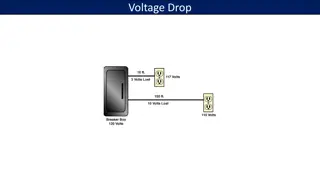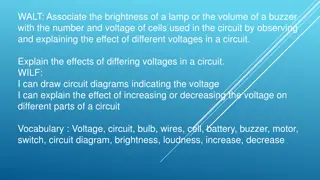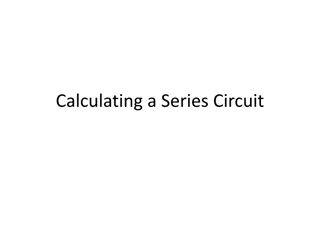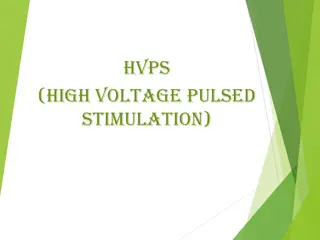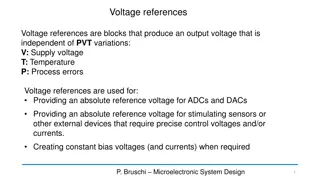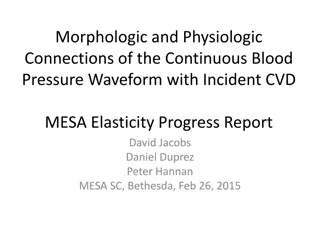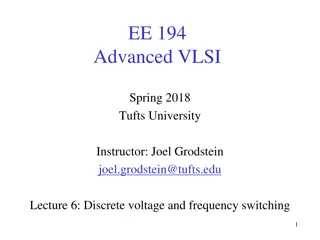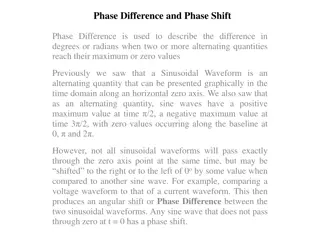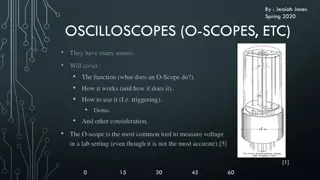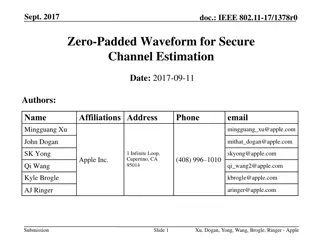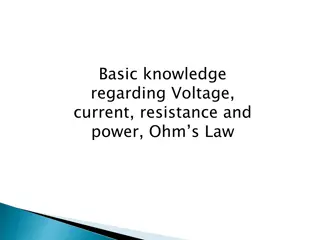Understanding Alternating Current and Voltage Waveforms
Alternating current and voltage exhibit specific waveform patterns such as sinusoidal waves. The sinusoidal waveform, including sine waves and harmonics, is fundamental in AC circuits. Sources like alternators produce sinusoidal voltages, while electronic signal generators create various waveforms for testing electronic systems. These instruments play a crucial role in manipulating and controlling electrical signals. Understanding the polarity and cycles of sine waves is essential in grasping the behavior of alternating current and voltage.
Download Presentation

Please find below an Image/Link to download the presentation.
The content on the website is provided AS IS for your information and personal use only. It may not be sold, licensed, or shared on other websites without obtaining consent from the author. Download presentation by click this link. If you encounter any issues during the download, it is possible that the publisher has removed the file from their server.
E N D
Presentation Transcript
ALTERNATING CURRENT AND VOLTAGE
THE SINUSOIDAL WAVEFORM The voltage or current fluctuates according to a certain pattern called a waveform. An alternating voltage is one that changes polarity at a certain rate, and an alternating current is one that changes direction at a certain rate.
THE SINUSOIDAL WAVEFORM The sinusoidal waveform sine wave is the fundamental type of alternating current (ac) and alternating voltage. The sine wave is a periodic type of waveform that repeats at fixed intervals.
THE SINUSOIDAL WAVEFORM In addition, other types of repetitive waveforms are composites of many individual sine waves called harmonics.
THE SINUSOIDAL WAVEFORM The Sinusoidal voltages are produced by two types of sources: Rotating electrical machines (Alternators) (Ac generators) Alternators are used in nearly all modern automobiles, trucks, tractors, and other vehicles.
Electronic Signal Generators The signal generator is an instrument that electronically produces sine waves for use in testing or controlling electronic circuits and systems. All signal generators consist of an oscillator, which is an electronic circuit that produces repetitive waves. All generators have controls for adjusting the amplitude and frequency.
Function generator It is an instrument that produces more than one type of waveform. It provides pulse waveforms as well as sine waves and triangular waves.
Electronic Signal Generators An arbitrary waveform generator can be used to generate standard signals like sine waves, triangular waves, and pulses as well as signals with various shapes and characteristics.
Polarity of a Sine Wave The combined positive and negative alternations make up one cycle of a sine wave.
Period of a Sine Wave The time required for a sine wave to complete one full cycle is called the period (T).
Period of a Sine Wave The period of a sine wave can be measured from a zero crossing to the next corresponding zero crossing, as indicated in Figure 4(a). The period can also be measured from any peak in a given cycle to the corresponding peak in the next cycle.
Period of a Sine Wave EXAMPLE 1 Show three possible ways to measure the period of the sine wave in Figure 6. How many cycles are shown?
Period of a Sine Wave Method 1: The period can be measured from one zero crossing to the corresponding zero crossing in the next cycle (the slope must be the same at the corresponding zero crossings).
Period of a Sine Wave Method 2: The period can be measured from the positive peak in one cycle to the positive peak in the next cycle.
Period of a Sine Wave Method 3: The period can be measured from the negative peak in one cycle to the negative peak in the next cycle.
Frequency of a Sine Wave Frequency (f ) is the number of cycles that a sine wave completes in one second.
Frequency of a Sine Wave EXAMPLE 2 Which sine wave in Figure 9 has a higher frequency? Determine the frequency and the period of both waveforms. FIGURE 9
Frequency of a Sine Wave In Figure 9(a), three cycles are completed in 1 s; therefore, f = 3 Hz One cycle takes 0.333 s (one-third second), so the period is T = 0.333 s FIGURE 9
Frequency of a Sine Wave In Figure 9(b), five cycles are completed in 1 s; therefore, f = 5 Hz One cycle takes 0.2 s (one-fifth second), so the period is T = 0.2 s FIGURE 9
SINUSOIDAL VOLTAGE AND CURRENT VALUES Instantaneous Value Figure 11 illustrates that at any point in time on a sine wave, the voltage (or current) has an instantaneous value.
SINUSOIDAL VOLTAGE AND CURRENT VALUES Instantaneous values of voltage and current are symbolized by lowercase v and i, respectively.
SINUSOIDAL VOLTAGE AND CURRENT VALUES Peak Value: The peak value of a sine wave is the value of voltage (or current) at the positive or the negative maximum (peak) with respect to zero. also called the amplitude
SINUSOIDAL VOLTAGE AND CURRENT VALUES Peak-to-Peak Value : The peak-to-peak value of a sine wave, as shown in Figure 13, is the voltage or current from the positive peak to the negative peak. It is always twice the peak value as
SINUSOIDAL VOLTAGE AND CURRENT VALUES RMS Value referred to as the effective value, of a sinusoidal voltage is actually a measure of the heating effect of the sine wave. Most ac voltmeters display rms voltage.
SINUSOIDAL VOLTAGE AND CURRENT VALUES The rms value of a sinusoidal voltage is equal to the dc voltage that produces the same amount of heat in a resistance as does the sinusoidal voltage.
SINUSOIDAL VOLTAGE AND CURRENT VALUES The peak value of a sine wave can be converted to the corresponding rms value using the following relationships for either voltage or current:
SINUSOIDAL VOLTAGE AND CURRENT VALUES The average value of a sine wave taken over one complete cycle is always zero because the positive values (above the zero crossing) offset the negative values (below the zero crossing). The average value is the total area under the half- cycle curve divided by the distance in radians of the curve along the horizontal axis. The result is derived in Appendix B
ANGULAR MEASUREMENT OF A SINE WAVE A sinusoidal voltage can be produced by an ac generator. There is a direct relationship between the rotation of the rotor in an alternator and the sine wave output. Thus, the angular measurement of the rotor s position is directly related to the angle assigned to the sine wave.
ANGULAR MEASUREMENT OF A SINE WAVE Angular Measurement: A degree is an angular measurement corresponding to 1/360oof a circle or complete revolution.
ANGULAR MEASUREMENT OF A SINE WAVE Table 1 lists several values of degrees and the corresponding radian values.
ANGULAR MEASUREMENT OF A SINE WAVE These angular measurements are illustrated in Figure 17.
ANGULAR MEASUREMENT OF A SINE WAVE Radian/Degree Conversion Degrees can be converted to radians. Radians can be converted to degrees.
Phase of a Sine Wave When the sine wave is shifted left or right with respect to this reference, there is a phase shift.
The Sine Wave Formula The sine wave amplitude (A) is the maximum value of the voltage or current on the vertical axis; angular values run along the horizontal axis. The variable y is an instantaneous value that represents either voltage or current at a given angle
The Sine Wave Formula The instantaneous voltage at a point along the horizontal axis as follows, where y = v and A = Vp
Expressions for Phase-Shifted Sine Waves When a sine wave is shifted to the right of the reference (lagging) by a certain angle , as in figure 26(a). The general expression is
Expressions for Phase-Shifted Sine Waves When a sine wave is shifted to the left of the reference (leading) by a certain angle, , as shown in Figure 26(b), the general expression is
Expressions for Phase-Shifted Sine Waves EXAMPLE Determine the instantaneous value at the reference point on the horizontal axis for each voltage sine wave in Figure 27
Phasor Representation of a Sine Wave The length of the phasor is the peak value of the sinusoidal voltage Vp, Thus, the opposite side of the triangle, which is the instantaneous value, can be expressed as
Phasor Representation of a Sine Wave EXAMPLE: For the Phasor in each part of Figure 32, determine the instantaneous voltage value. The length of each represents the peak value of the sinusoidal voltage..
Phasor Representation of a Sine Wave (A) v = (10 V)sin 0 = (10 V)(0) = 0 V (B)v = (10 V)sin 30 = (10 V)(0.5) = 5 V (C )v = (10 V)sin 90 = (10 V)(1) = 10 V
Phasor Representation of a Sine Wave v = (10 V)sin 135 = (10 V)(0.707) = 7.07 V v = (10 V)sin 270 = (10 V)(-1) = - 10 V v = (10 V)sin 330 = (10 V)(-0.5) = - 5 V
Phasor Diagrams A phasor diagram can be used to show the relative relationship of two or more sine waves of the same frequency.
Phasor Diagrams Example: Use a phasor diagram to represent the sine waves in Figure 34.
Phasor Diagrams Solution: The phasor diagram representing the sine waves is shown in Figure 35.
Angular Velocity of a Phasor Since, one cycle of a sine wave is traced out when a phasor is rotated through 3600or 2 radians in a time equal to the period, T, the angular velocity (distance/time) can be expressed as.
Angular Velocity of a Phasor When a phasor is rotated at an angular velocity then t is the angle through which the phasor has passed at any instant. Therefore, the following relationship can be stated:



